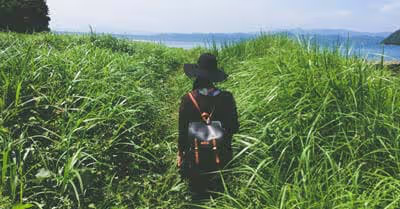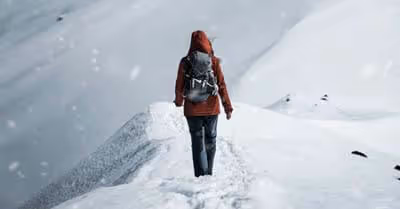Table of Contents
The origin of hiking poles
Trekking poles have existed for hundreds of years, these were often just plain old sticks. Sometimes they were more crudely carved and might be reinforced with metals, but not often. Many mountain guides used them for trekking through Europe’s many mountain ranges to help test footing and ward off predators. When it wasn’t possible to see the ground because it was covered in a foot of snow, these poles would come in useful
These trekking poles have developed over time. Nowadays, poles can be extended and retracted for each person’s size and needs. These poles are based on ski poles and are very well designed, their materials are now metal, plastic and carbon fiber opposed to just simply wood. These trekking poles have developed into what we call hiking poles and are becoming more and more popular with outdoor fanatics and the more casual walkers alike.
In 1979, Mauri Repo published a book about something called “Nordic Walking”. This is a casual walking sport using these specially designed hiking poles. It is a sport that can be done by anyone, anywhere, which is why it is growing in popularity. Originally ski poles were used for this sport, but over time with the increased availability of hiking poles, they have become the norm.
How to use hiking poles correctly
When you buy your hiking poles, make sure to get the adjustable ones. Nothing is worse than finding out your new poles are not a comfortable height for you an hour into using them. You will also want to adjust your poles when going uphill, or down.
When going uphill, you will want to shorten your poles so you don’t have to lean so far backward. It is unsafe to walk with them at full length going uphill because you want to be leaning into the hill as much as possible for safety and comfort. Having long hiking sticks will make this impossible.
Conversely, when walking downhill you want to lengthen your poles as much as is comfortable. This will allow you to use the poles to help yourself walk upright. You will be less likely to slip and fall going downhill this way.
The Benefits of hiking poles
Help your knees:
Hiking can be hard on your knees, it is a lot of extra strain they might not be used too. This is exaggerated if you are carrying a large pack around with you. The poles allow you to displace your weight when walking, allowing your poles (and to an extent your arms) to play their part in load managing. The biggest benefits to your knees are when going downhill, as there is much less strain on them.
Balance and safety:
When going up or down steep inclines, having adjustable hiking poles can help you maintain your balance much more easily. They make walking stood vertically much easier because you can adjust their lengths to offset whatever degree of incline you are walking at. When walking through streams and shallow rivers having hiking poles can help you keep your footing.
Checking trails:
Not all trails are dangerous and slippy, but some can be. Your hiking poles can be used to test the paths you are walking for any potential dangers. This is most beneficial when scrambling on rocky trails up or downhill. By prodding the rocks with your poles you can see if they are sturdy enough to make suitable footings or are simply going to give way under your feet. As mentioned above, these poles can help you keep your balance when walking through streams and rivers, but they are also great for pathfinding. The poles can be used for testing footing that you can’t otherwise see under the water. This is especially useful when the waters don’t run clear and you have no idea what might be under the surface.
The drawbacks of hiking poles
Heavy:
Carrying poles with you has its upsides, but also some drawbacks. One of the major ones being that the poles are not light, even the carbon fiber ones can start to wear you out over prolonged periods. You may not wish to use them on flat trail sections, which means you are just lugging around extra weight. Most people don’t equate having really tired arms with hiking but this is a real possibility when using hiking poles. A good way to prepare for this is by starting to work out your arms using small 10 pound weights. This can be done while watching tv for 15 minutes a day. It may be a bit inconvenient, but it will make your next hike much easier on your arms.
Inconvenient:
Poles are inconvenient to look after on long treks. You won’t always be using them, but you will always have to carry them. They are another responsibility for you during camping too, they are easily lost and must be kept watch over. A good way of dealing with this is by tying them together, and then also tying them to your pack.
Not only are they inconvenient to look after, but they can also be inconvenient to use too. They catch and snag on brush and branches when walking on overgrown trails. Trying to avoid tripping over and hurting yourself by catching your poles on branches is a full-time job.
Expensive:
Hiking poles are not cheap. Some of the nicer, carbon fiber, ones can set you back a pretty penny. If you chose hiking as a cheap and easy hobby to get into, suddenly feeling you need to purchase not just one but two expensive hiking poles is not ideal. There are cheaper ones available, but you are wasting your money if you don’t get adjustable ones. Furthermore, if you want lighter poles that are easier to carry, you are going to have to spend much more money. The cheaper ones are metallic, not carbon fiber, and are many times heavier.
If you do decide to buy cheaper ones, such as ones made of plastic, you are likely to break them when they come under a lot of stress. Aside from this being a waste of money, if they break whilst you are walking downhill you could fall and it could lead to a severe injury.
Injuries:
Whilst hiking poles can help prevent a lot of injuries, there are some that it can cause. When walking with poles, you would typically have your hands through the straps to make sure you don’t drop and then lose them. Whilst this is good, it does lead to some potential disasters. If you fall over with your hands through the “safety straps” you may not be able to protect yourself when falling and may end up flat on your face. Aside from being embarrassing, this can be potentially fatal. It isn’t just head injuries that are a risk. If your hands are stuck and the pole catches during your fall, you can very easily break your wrists and or hands. All of these injuries become so much worse if you are a 10-hour hike from civilization.
Damage to nature:
One of the biggest rules of the outdoorsman is respect nature, don’t leave anything you brought with you there, and do your best to leave everything as you found it. This is a very important rule, one that everyone should follow religiously. Walking with these hiking poles can be damaging to nature, they are typically very sharp and made of metal underneath. This is of course for grip, but it also means that you will potentially damage plant life that you are walking through. There is an argument to be made that you would damage it with your feet anyway, but you are far more likely to damage it with a sharp metallic pole than your footsteps.
Bottom Line
So, do you need hiking poles? That is up to you. There are so many benefits to using them, especially if you plan to be walking over very long distances. Navigating difficult terrain, especially rivers and streams, is much easier with the help of hiking poles than it might otherwise be. They are particularly useful when going up and down hills. On the downside, they can be expensive and are just as likely to cause an injury as they are to prevent one. If you were looking for a cheap hobby that has no real entry cost to get into, hiking is a fantastic choice, but not if you need to shell out a couple of hundred dollars for hiking poles. My suggestion would be, you don’t need to buy hiking poles. You will be perfectly fine without them. Whether or not you wish to use them is of course up to you, I hope this article provided you with the information you needed to make that decision. Good luck!
Recent Articles
















